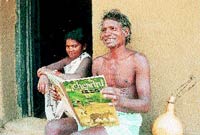Makar Sankarati festival with difference
Today, I am talking about a festival which actually
ushers to the new phase of almost everything in terms of seasons, solar transit
and social activity. That’s the festival we celebrate here as Makar Sankranti
This is termed as the New Year here. And according to the religion it allows us to start the
holy or auspicious activities like marriage alliance and house warming ceremony.
One festivals with different names:
The festival is known by different names in
different parts of our country. Let’s check out a few of them!
Pongal in Tamilandu
Lohari in Punjab
Uttarayan in Gujrat
Poush Sangkranti in West Bengal
What happens with celestial bodies on Makar Sankranti?
During the period the transit of sun from winter to
summer solstice and sun enters into zodiac sign of Capricorn. with that, the days become longer and nights shorter.
Since I am from central India, I would talk about the
way it is celebrated here, In our region, people make sweets of sesame-seeds
and jaggery. They generally make food stuff called “laddu” out of it and give it to everyone
wishing them prosperous life ahead exactly the way we do quite often on the eve
of 31 December every year.
 |
| "Laddu" made of sesame seeds and jaggery |
While celebrating 31 December we often go for picnic
trip and enjoy with our friends family and relatives.
Distribution of
“laddu” means that we eat them and speak out as
sweet as the laddu itself.
People visit their relatives and send them “Sakraat”,
a collection of dal(Pulses) rice, grains, sweets, jaggery, sesame seeds
and other items.
In Rajasthan and Gujarat people celebrate this
festival by flying kites and exchanging gifts as a part of festival. The
movement of wind takes different turn so the flying kites symbolizes track the
direction of the wind.
In South India, people celebrate it as Pongal. They have
a 4 days festival which is organized in a grand way. Each day is dedicated to
some auspicious work, generally cleaning the house on the first day, making
offerings and bhoga (offerings) to Lord Suryadev (Sun-God) on the second day, worshiping the cattle
on the third day and visiting the relatives on the fourth day.
 |
| Sankranti as Lohari in Punjab (Google photo) |
In areas like Uttar Pradesh where there is confluence
of a holy river, people go to take a holy dip in the Ganges and after taking
bath, they offer prayers and bhoga (offerings) to the sun
(considering the sun as God) and other demigods. They usually fast on this day
and spend time in listening to Hari Katha (religious
preaching/talks) and feeding the Brahmins.
For more please click HERE.






0 Comments
Awaiting your comments!